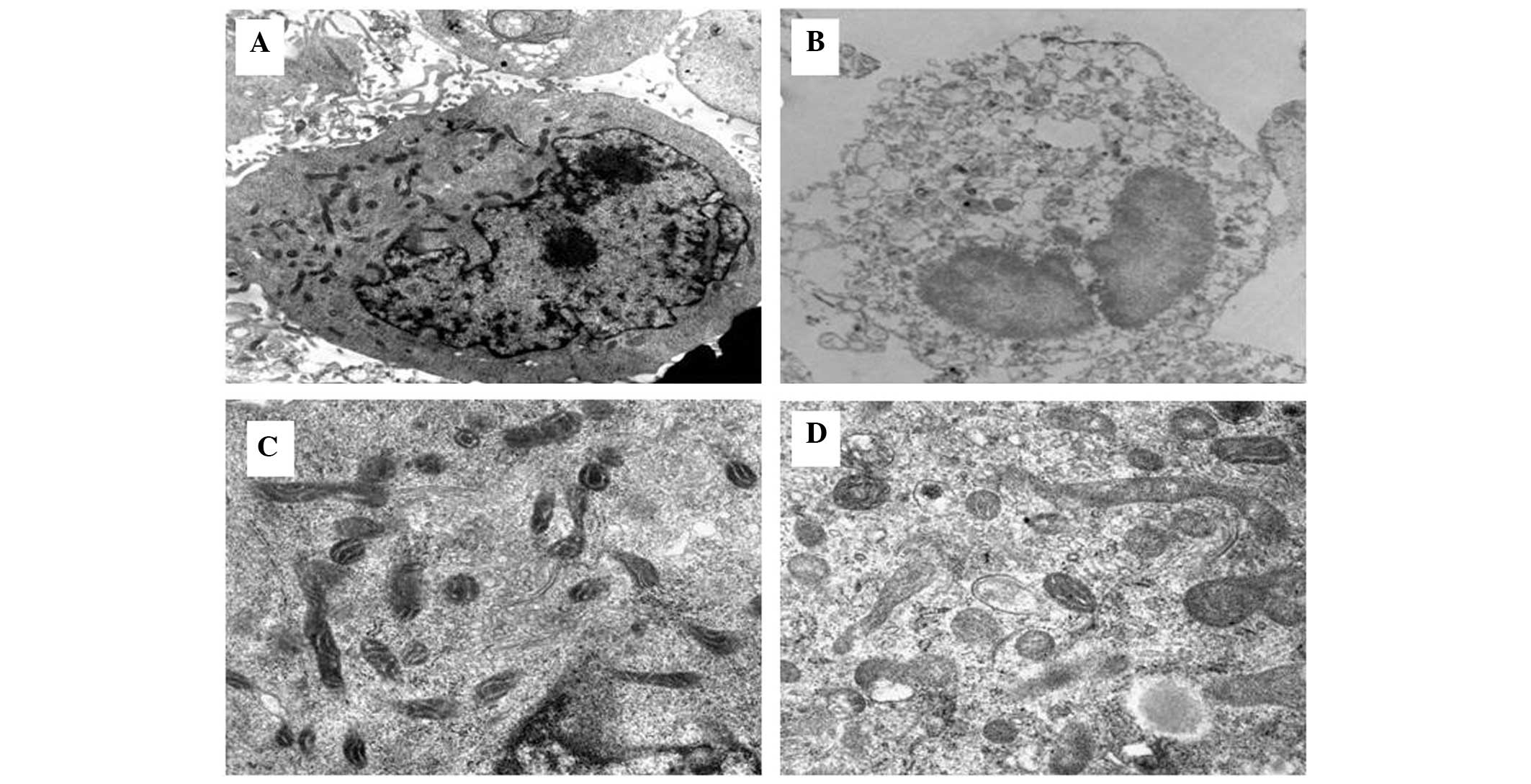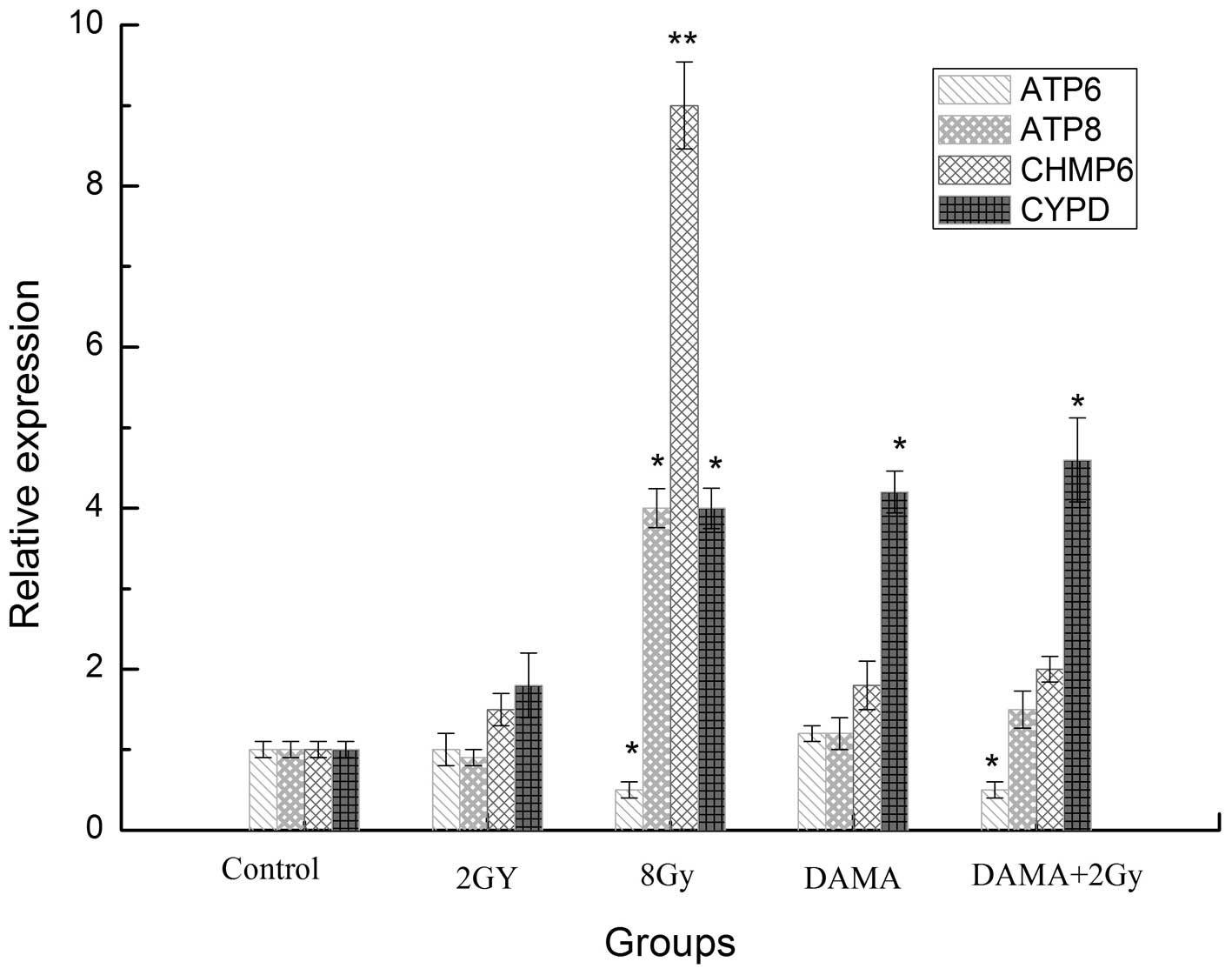|
1
|
Jia WH, Huang QH, Liao J, Ye W, Shugart
YY, Liu Q, Chen LZ, Li YH, Lin X, Wen FL, et al: Trends in
incidence and mortality of nasopharyngeal carcinoma over a 20–25
year period (1978/1983–2002) in Sihui and Cangwu counties in
southern China. BMC Cancer. 6:1782006.PubMed/NCBI
|
|
2
|
Liu Y, Hou H, Li DR, et al: Enhancement
effect of emodin on radiosensitivity of human nasopharyngeal
carcinoma transplanted in nude mice. Chinese Pharmaceutical
Journal. 45:1331–1334. 2010.
|
|
3
|
Liu Y, Hou H, Li DR, et al: Correlation of
enhancement radiosensitization of emodin isolated from Guangxi P.
multiflorum Thunb on hypoxic nasopharyngeal cancer cells with
expression of DNA repair genes. Chinese Pharmacological Bulletin.
25:348–352. 2009.
|
|
4
|
Liang Y, Hou HX, Li DR, Qin CM, Chen DL
and Wu HH: Synthesis of 1,8-dihydroxy-3-acetyl-6-methyl-9,10
anthraquinone and its inhibition effect on ovarian carcinoma cells
SKOV3. Chinese Journal of New Drugs. 2012.1038–1041. 2012.(In
Chinese).
|
|
5
|
Miyoshi N, Watanabe E, Osawa T, et al: ATP
depletion alters the mode of cell death induced by benzyl
isothiocyanate. Biochim Biophys Acta. 1782:566–573. 2008.
View Article : Google Scholar : PubMed/NCBI
|
|
6
|
Lieberthal W, Menza SA and Levine JS:
Graded ATP depletion can cause necrosis or apoptosis of cultured
mouse proximal tubular cells. Am J Physiol. 274:F315–F327.
1998.PubMed/NCBI
|
|
7
|
Levin S: Apoptosis, necrosis, or oncosis:
what is your diagnosis? A report from the Cell Death Nomenclature
Committee of the Society of Toxicologic Pathologists. Toxicol Sci.
41:155–156. 1998. View Article : Google Scholar
|
|
8
|
Zhou X, Sun WJ, Wang WM, et al: Artesunate
inhibits the growth of gastric cancer cells through the mechanism
of promoting oncosis both in vitro and in vivo. Anticancer Drugs.
24:920–927. 2013. View Article : Google Scholar : PubMed/NCBI
|
|
9
|
Ma LS, Jiang CY, Cui M, et al: Fluopsin C
induces oncosis of human breast adenocarcinoma cells. Acta
Pharmacol Sin. 34:1093–1100. 2013. View Article : Google Scholar : PubMed/NCBI
|
|
10
|
Sun L, Zhao Y, Yuan H, et al: Solamargine,
a steroidal alkaloid glycoside, induces oncosis in human K562
leukemia and squamous cell carcinoma KB cells. Cancer Chemother
Pharmacol. 67:813–821. 2011. View Article : Google Scholar : PubMed/NCBI
|
|
11
|
Chaudhry MA and Omaruddin RA:
Mitochondrial gene expression in directly irradiated and
nonirradiated bystander cells. Cancer Biother Radiopharm.
26:657–663. 2011. View Article : Google Scholar : PubMed/NCBI
|
|
12
|
Gu ML, Wang YJ, Shi L, Zhang YB and Chu
JY: Comparison on mitochondrial ATP6, ATP8 and Cyt b genes between
Chinese Tibetans in three different zones: detecting the signature
of natural selection on mitochondrial genome. Yi Chuan. 31:147–152.
2009.(In Chinese).
|
|
13
|
Lieberthal W, Triaca V and Levine J:
Mechanisms of death induced by cisplatin in proximal tubular
epithelial cells: apoptosis vs. necrosis Am J Physiol.
270:F700–F708. 1996.PubMed/NCBI
|
|
14
|
Mallat Z and Tedgui A: Apoptosis in the
vasculature: mechanisms and functional importance. Br J Pharmacol.
130:947–962. 2000. View Article : Google Scholar : PubMed/NCBI
|
|
15
|
Contamine V and Picard M: Maintenance and
integrity of the mitochondrial genome: a plethora of nuclear genes
in the budding yeast. Microbiol Mol Biol Rev. 64:281–315. 2000.
View Article : Google Scholar : PubMed/NCBI
|
|
16
|
Arnold RS, Sun CQ, Richards JC, et al:
Mitochondrial DNA mutation stimulates prostate cancer growth in
bone stromal environment. Prostate. 69:1–11. 2009. View Article : Google Scholar : PubMed/NCBI
|
|
17
|
Nakagawa T, Shimizu S, Watanabe T, et al:
Cyclophilin D-dependent mitochondrial permeability transition
regulates some necrotic but not apoptotic cell death. Nature.
434:652–658. 2005. View Article : Google Scholar
|
|
18
|
Baines CP, Kaiser RA, Purcell NH, et al:
Loss of cyclophilin D reveals a critical role for mitochondrial
permeability transition in cell death. Nature. 434:658–662. 2005.
View Article : Google Scholar : PubMed/NCBI
|
|
19
|
Fu D, Tian L, Peng Z, et al:
Overexpression of CHMP6 induces cellular oncosis and apoptosis in
HeLa cells. Biosci Biotechnol Biochem. 73:494–501. 2009. View Article : Google Scholar : PubMed/NCBI
|
|
20
|
Tsujimoto Y and Shimizu S: Role of the
mitochondrial membrane permeability transition in cell death.
Apoptosis. 12:835–840. 2007. View Article : Google Scholar : PubMed/NCBI
|
|
21
|
Javadov S and Kuznetsov A: Mitochondrial
permeability transition and cell death: the role of cyclophilin d.
Front Physiol. 4:762013. View Article : Google Scholar : PubMed/NCBI
|














